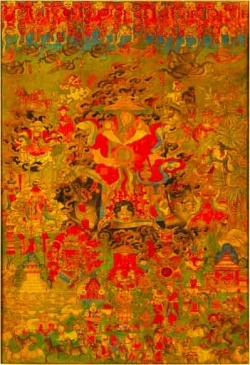Pehar offering thangka
This haunting and vivid painting represents offerings to Pehar(pehar has five aspects: body, Mind, speech, Knowledge{quality}and Acitvity, each of whom is represented differently. The specific form portrayed in the present example is unclear because it incorporates iconographical elements from several aspects. Yonten Gyalpo{knowledge} can sometimes be portrayed riding a horse, but it is Kui Gylpo{body} who typically holds a vajra. Moreover, more than one aspect of Pehar wears the distincitive cymbal-shaped hat seen in the present example), who is not actually represented but must be invoked by the practitioner through visualization. Pehar is a reincarnation of the demon Mudu Tankhar, who was subjugated by padmasambhava in the eighth century. He was subsequently designated by Padmasambhava to be the guardian of Samye but later transferred his residence to the monastery at Nechung, also near Lhasa.
At the centre of the thanka a black horse, the deity’s mount, gallops against a halo of smoky flames. He is caparisoned with jewelled straps and tassels, and blankets and the flayed skin of demon have been draped across his back. Pehar’s form is indicated by the voluminous robes that he would have been wearing and the distinctive cymbal-shaped hat (tipshu) hovering above the void where his head would have been. Similarly, a dorje and staff are suspended at his sides respectively. Surrounding the deity is a bizarre and macabre landscape of animals and birds, offerings of blood, jewels and auspicious symbols, weapons, tutelary deities and other emanations of Pehar. Along the top of the painting, skulls, decapitated heads and the flayed skins of animals and humans form a curtain beneath which Garuda, with a serpent in his beak, and other birds holding entrails in theirs, are flying.
This thanka belongs to a painting genre known as ‘Assembly of Emblems’ (rgyan tshogs), and works such as this one would have been used in chapels, where rites were peformed to invoke protection.(for other information and exmaples of this genre of painting, see Literature)The absence of the actual embodiment of the deity suggests his omnipresence, whose vast energies are capable of appearing simultaneously in more than one place. (Rhie and Thurman {1999}, p.489)
